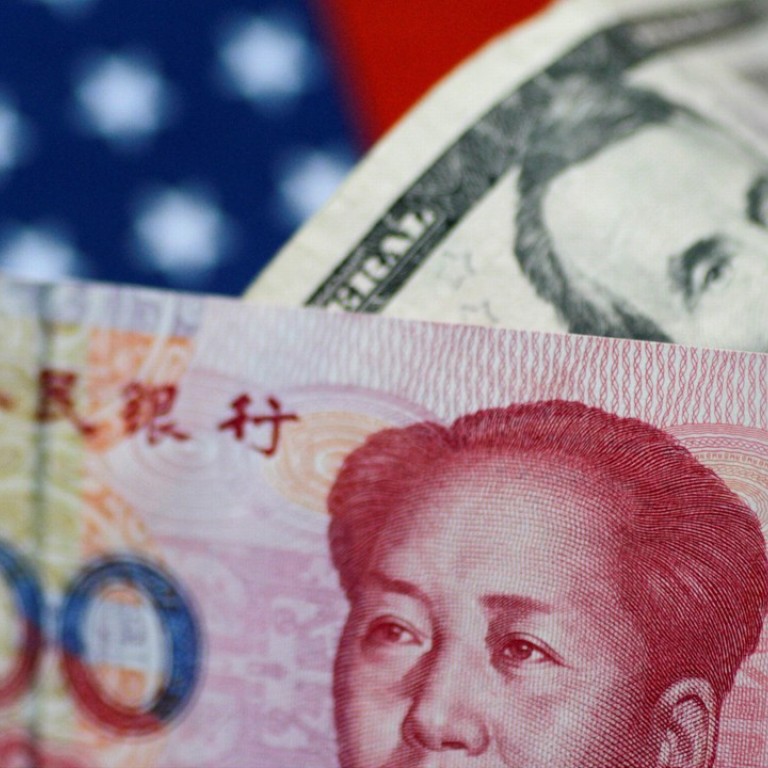
US$1 for 19.77 yuan? How a bogus social media rumour reveals fear that China is printing money
The yuan should be worth 19.77 to the dollar, not the current rate of 6.9, according to a theory that has been debunked but speaks of a broader worry
A layman theory about China’s yuan, suggesting it should be worth 19.77 to the US dollar – about three times the current exchange rate of 6.9 – has gained popularity on Chinese social media, reflecting fears that the currency is entering a long cycle of depreciation.
The US Treasury Secretary will review Beijing’s exchange rate policy this week to decide whether to label China a currency manipulator. US President Donald Trump alleged China manipulated the yuan during his election campaign, arguing that Beijing was deliberately keeping the yuan cheap.
The theory surfaced in a number of social media accounts as long ago as June, but has been spreading rapidly since September after appearing on Zhihu, a Quora-style question-and-answer website, and Tianya.cn, an online bulletin board.
According to the theory, the fair exchange rate between the yuan and the dollar can be calculated solely using the respective GDP and total money supply of China and the United States.
The US had a GDP of US$19.36 trillion in 2017 and money supply, or M2, of US$13.92 trillion, resulting in a M2/GDP ratio of 0.719. Applying the same ratio, China’s US$12.24 trillion economy should have had US$8.8 trillion of money supply at the end of 2017. Instead, China’s actual money supply was 174 trillion yuan (about US$26 trillion at the current exchange rate), meaning – going by the M2/GDP formula – the actual value of a US dollar should be 19.77 yuan.
While this argument has fundamental flaws – such as assuming the US and China should have the same M2/GDP ratio – its simplicity has helped it to gain popularity on Chinese social media platforms including WeChat and Weibo, and stirred debates involving reputable economists.
Guan Tao, who works for a think tank and is a former senior official with China’s State Administration of Foreign Exchange, which is in charge of China’s foreign exchange policies, wrote an opinion piece in the Securities Times newspaper last week to dismiss the theory as sensationalist and without academic or empirical foundation.
It shows that people are worried the central bank has pumped too much money into the economy … and shows panic and fear about the yuan’s exchange rate
“This theory is just another form of the argument that China has printed money excessively and the yuan is set to devalue,” Guan wrote.
Calculating exchange rates by the M2/GDP ratio, Guan wrote, could not explain previous exchange-rate movements of the yuan and other major currencies.
Guan suggested that the theory that US$1 should equal 19.77 yuan, while lacking credibility, reflected a widespread pessimistic view of China’s prospects because “the market tends to trust bad news amid widespread pessimism”.
Zhao Jian, the head of Atlantis Finance Research Institute, a financial think tank, said in a telephone interview with the South China Morning Post that the theory was “self-contradictory” and contained no “academic value”.
He said the notion that China’s GDP was US$12 trillion in 2017 had already accepted an exchange rate of 6.757 yuan to the dollar, using a conclusion to overturn an assumption that is vital to reach that conclusion.
However, Zhao admitted the fear about excessive money printing in China was real.
“It shows that people are worried the central bank has pumped too much money into the economy … and shows panic and fear about the yuan’s exchange rate,” he said.
Professional foreign exchange traders are expecting modest yuan depreciation but few are forecasting it to tumble like Argentina’s peso or the Turkish lira.
In a survey of 18 traders and analysts by Bloomberg News conducted last week, just three said the Chinese currency would breach the 7 mark before the end of 2018, and a majority said the yuan would not weaken above 7 to the dollar until the middle of 2019.
The Chinese government has repeatedly said it has no intention to weaken the yuan as a means to boost exports during the trade war with the United States, and the People’s Bank of China, the Chinese central bank, has been using draconian controls and direct intervention to avoid any dramatic weakening of the yuan.
At the same time, Zhao said Beijing’s rigid control over the exchange rate had instilled mistrust in the official prices, enabling outlandish theories and wild guesses to flourish.
“One of China’s problems is that the yuan was not allowed to float freely,” he said.
Lemon Zhang, a foreign exchange strategist with Standard Chartered bank, said the yuan was falling because many thought Beijing would allow it to break the 7 level soon and investors were buying the dollar.
Robin Xing, chief China economist for Morgan Stanley, said at a media briefing in Beijing on Monday that since August China had made clear its intention of stabilising the yuan exchange rate against a basket of currencies, which meant the yuan would weaken against the US dollar if the dollar was strengthening against other currencies.
“In the long run, the rate will be decided by the flows of current and capital accounts. Now the current account has largely been balanced, which doesn’t support a large appreciation or depreciation,” Xing said.
Additional reporting by Frank Tang

